 All over the continent of Australia, you will find stout, with short, soft fur and pointed eared wild dogs called the Dingo. The name dingo was used by the Aborigines of Australia and first appeared sometime in 1979 in writing. They have very attractive coats in various colors which includes cream, pale yellow, white, dark red brown, rusty red, yellowish brown and black. Pure bred adult dingoes always have white tip in their tails and usually you will notice that they also have white feet regardless what color their coats have. An adult dingo could stand at about two feet at the shoulder and almost four feet in length from nose to tail. Compared to a common domesticated dog of the same size, a dingo has a larger skull and has longer teeth however, both can be interbred.
All over the continent of Australia, you will find stout, with short, soft fur and pointed eared wild dogs called the Dingo. The name dingo was used by the Aborigines of Australia and first appeared sometime in 1979 in writing. They have very attractive coats in various colors which includes cream, pale yellow, white, dark red brown, rusty red, yellowish brown and black. Pure bred adult dingoes always have white tip in their tails and usually you will notice that they also have white feet regardless what color their coats have. An adult dingo could stand at about two feet at the shoulder and almost four feet in length from nose to tail. Compared to a common domesticated dog of the same size, a dingo has a larger skull and has longer teeth however, both can be interbred.
These dogs has been a topic of long-standing debates in Australia whether to give them a right to live in the wild or should they be fenced and eventually be destroyed. The dingoes were not a native of the Australian continent. They had probably arrived there by boat but as to when and by whom, we do not know. Studies show that fossil remains have strong resemblance to Indus Valley dogs that were crossed by domestic dogs with Indian wolf.
A dingo puppy is a very cute and charming little animal. Aborigines usually keep them as pets. However, as they grow, they eventually go back to the wild. Despite the efforts of taming them by humans, the dingoes that roam in the wild are a ferocious hunter. They are the main reason for the loss of many flocks of sheep and herds of cattle in Australian farms and ranch.
Dingoes are known cunning hunters. They rarely hunt in packs. Normally, they are known as lone hunters. Sometimes though, they hunt in pairs especially on large animals. They often tail a flock of sheep or herds of cattle for several days, picking off those that stray from the flock. Reports tell us that nearly 50 percent of the newborn lambs or calves were lost to the dingoes. And most often than not, they would kill an animal and eat only little from the carcass which further infuriates the farmers. No wonder these dogs are so controversial in Australia.
With these problems, the government made efforts to control the increasing numbers of this so called menace dogs of Australia. This includes the 2.5 meter high fence installed around the northern part of the known “sheep country” which stretched more than 8,000 kilometers. This “great dingo fence” is believed to be longer than the Great Wall of China. Aside from the fencing of almost the most part of the area, they have also tried poisoning them. Others like the professional “doggers” trap and kill them with their baits and shooting them. While efforts were made to control and eliminate them, the dingoes are also fighting for the survival of their species.